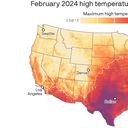February saw extreme weather across the U.S.

February's extreme weather events left distinct patterns across the country — and shifted Americans' ideas of what winters now look like.
Why it matters: The month's warmth means that the meteorological winter of 2023-2024 — which includes December, January and February — will very likely be the Lower 48 states' warmest on record.
The big picture: This winter was anything but ordinary, featuring sizzling heat waves more typical for mid-summer than late February, along with flooding rains in the East, a dry and mild Midwest, and a fusillade of atmospheric river storms hitting the West Coast.
- Many cities in the northern tier of the country busted their previous records for their warmest winter, according to preliminary data.
- This includes the Twin Cities, where the season is being referred to as the Lost Winter, due to the mild temperatures and lack of snowfall. Fargo, N.D. unbelievably saw a (preliminary) seasonal temperature anomaly of 14°F above average, a staggering figure for such a three-month-long milestone.
Zoom in: The weather and climate extremes, many of which are evident in the maximum temperature and precipitation totals maps, can be tied most clearly to an El Niño climate pattern in the tropical Pacific Ocean, plus the increasingly clear influence of human-caused global warming.